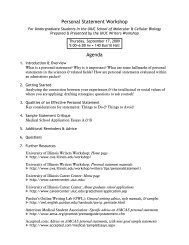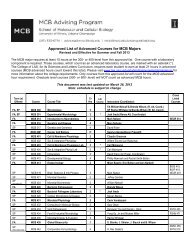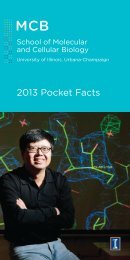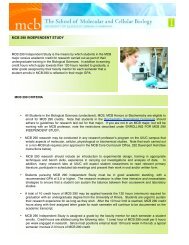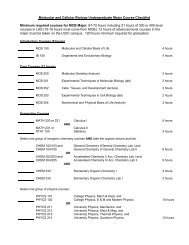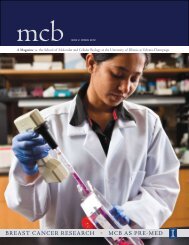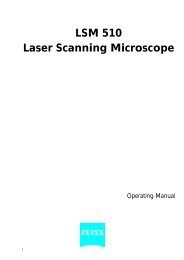collaboration in the life sciences - The School of Molecular and ...
collaboration in the life sciences - The School of Molecular and ...
collaboration in the life sciences - The School of Molecular and ...
You also want an ePaper? Increase the reach of your titles
YUMPU automatically turns print PDFs into web optimized ePapers that Google loves.
FROM GOOD CHOLESTEROL<br />
to blood clott<strong>in</strong>g<br />
by col<strong>in</strong><br />
WRAIGHT<br />
jim MORRISSEY<br />
Pr<strong>of</strong>essor <strong>of</strong> Biochemistry <strong>and</strong> Medical<br />
Biochemistry James Morrissey, as a postdoctoral<br />
fellow at <strong>the</strong> Scripps Research<br />
Institute, began study<strong>in</strong>g components <strong>of</strong><br />
<strong>the</strong> protease cascade that controls blood coagulation,<br />
<strong>in</strong>itiat<strong>in</strong>g a <strong>life</strong>-long <strong>in</strong>terest <strong>in</strong> underst<strong>and</strong><strong>in</strong>g how cells<br />
regulate blood clott<strong>in</strong>g <strong>in</strong> health <strong>and</strong> disease.<br />
Simplified blood clott<strong>in</strong>g cascade.<br />
Morrissey <strong>and</strong> colleagues are reveal<strong>in</strong>g structure-based mechanisms <strong>of</strong> <strong>the</strong><br />
major cascade “factors,” <strong>and</strong> <strong>the</strong> essential role that <strong>the</strong> cell membrane surface<br />
plays <strong>in</strong> activat<strong>in</strong>g key members <strong>of</strong> <strong>the</strong> cascade. This work is lead<strong>in</strong>g to <strong>the</strong><br />
development <strong>of</strong> <strong>the</strong>rapeutic <strong>in</strong>terventions for thrombosis <strong>and</strong> to novel hemostatic<br />
agents to stem traumatic <strong>and</strong> surgical bleed<strong>in</strong>g.<br />
In 2006, Morrissey, work<strong>in</strong>g with post-doctoral associate Stephanie Smith,<br />
discovered that polyphosphate (polyP, a polymer <strong>of</strong> <strong>in</strong>organic phosphate) is a<br />
potent modulator <strong>of</strong> blood coagulation, <strong>and</strong> is present <strong>in</strong> <strong>the</strong> dense granules <strong>of</strong><br />
platelets <strong>in</strong> <strong>the</strong> blood. Subsequent work by Morrissey’s group showed that polyP<br />
triggers <strong>the</strong> so-called contact pathway <strong>of</strong> blood clott<strong>in</strong>g.<br />
A parallel l<strong>in</strong>e <strong>of</strong> research <strong>in</strong> <strong>the</strong> Morrissey lab has been underst<strong>and</strong><strong>in</strong>g <strong>the</strong><br />
biochemical details <strong>of</strong> ano<strong>the</strong>r important process <strong>of</strong> blood clott<strong>in</strong>g, <strong>the</strong> tissue<br />
factor pathway. Here, <strong>the</strong> <strong>in</strong>itiation event takes place when tissue damage<br />
exposes <strong>the</strong> soluble plasma prote<strong>in</strong>, factor VII (fVII, a latent protease), to <strong>the</strong><br />
<strong>in</strong>tegral membrane prote<strong>in</strong>, tissue factor (TF), on <strong>the</strong> surface <strong>of</strong> extravascular<br />
cells. Once bound to TF, fVII is rapidly converted to its active form, fVIIa,<br />
which is ma<strong>in</strong>ta<strong>in</strong>ed <strong>in</strong> an active TF-fVIIa complex. <strong>The</strong> membrane surface<br />
<strong>and</strong> its specific composition are crucial for <strong>the</strong> functional association <strong>of</strong> TF<br />
with fVIIa <strong>and</strong> for <strong>the</strong> activity <strong>of</strong> <strong>the</strong> TF-fVIIa complex <strong>in</strong> convert<strong>in</strong>g factor<br />
X (fX) to its active form fXa. FXa is <strong>the</strong> common element between <strong>the</strong> tissue<br />
factor pathway <strong>and</strong> contact pathway <strong>of</strong> coagulation, <strong>and</strong> <strong>in</strong>itiates <strong>the</strong> f<strong>in</strong>al<br />
steps <strong>of</strong> <strong>the</strong> proteolytic cascade that forms blood clots.<br />
Schematic <strong>of</strong> TF, fVIIa, <strong>and</strong> fX assembled<br />
on a nanodisc surface.<br />
<strong>The</strong> critical role <strong>of</strong> <strong>the</strong> membrane surface makes <strong>the</strong> coagulation cascade<br />
especially difficult to <strong>in</strong>vestigate, but key developments <strong>in</strong> o<strong>the</strong>r labs <strong>in</strong> <strong>the</strong><br />
Department <strong>of</strong> Biochemistry provided <strong>the</strong> ideal approach to study it at a<br />
molecular level.<br />
Lateral th<strong>in</strong>k<strong>in</strong>g<br />
A <strong>life</strong>time <strong>of</strong> <strong>in</strong>terest <strong>in</strong> lipids <strong>and</strong> lipoprote<strong>in</strong>s led Pr<strong>of</strong>essor Emerita <strong>of</strong><br />
Biochemistry Ana Jonas to a structural model <strong>of</strong> high density lipoprote<strong>in</strong>s<br />
(HDL). <strong>The</strong>se so-called “good cholesterol” particles, which carry lipids <strong>and</strong><br />
cholesterol <strong>in</strong> <strong>the</strong> blood for recycl<strong>in</strong>g <strong>in</strong> <strong>the</strong> liver, consist <strong>of</strong> two molecules<br />
<strong>of</strong> <strong>the</strong> prote<strong>in</strong> component, apoA, wrapped around a bilayer <strong>of</strong> phospholipids<br />
<strong>and</strong> cholesterol, form<strong>in</strong>g a roughly 10 nm diameter disc. In addition to <strong>the</strong><br />
belt-form<strong>in</strong>g region, apoA also has a globular component, which serves as a<br />
h<strong>and</strong>le for b<strong>in</strong>d<strong>in</strong>g to its cellular targets, such as <strong>in</strong> <strong>the</strong> liver.<br />
Gla-doma<strong>in</strong> <strong>in</strong>teract<strong>in</strong>g with a phospholipid<br />
bilayer (detail from a full molecular dynamics<br />
simulation <strong>of</strong> fVII by Emad Tajkhorshid).<br />
8 . mcb



